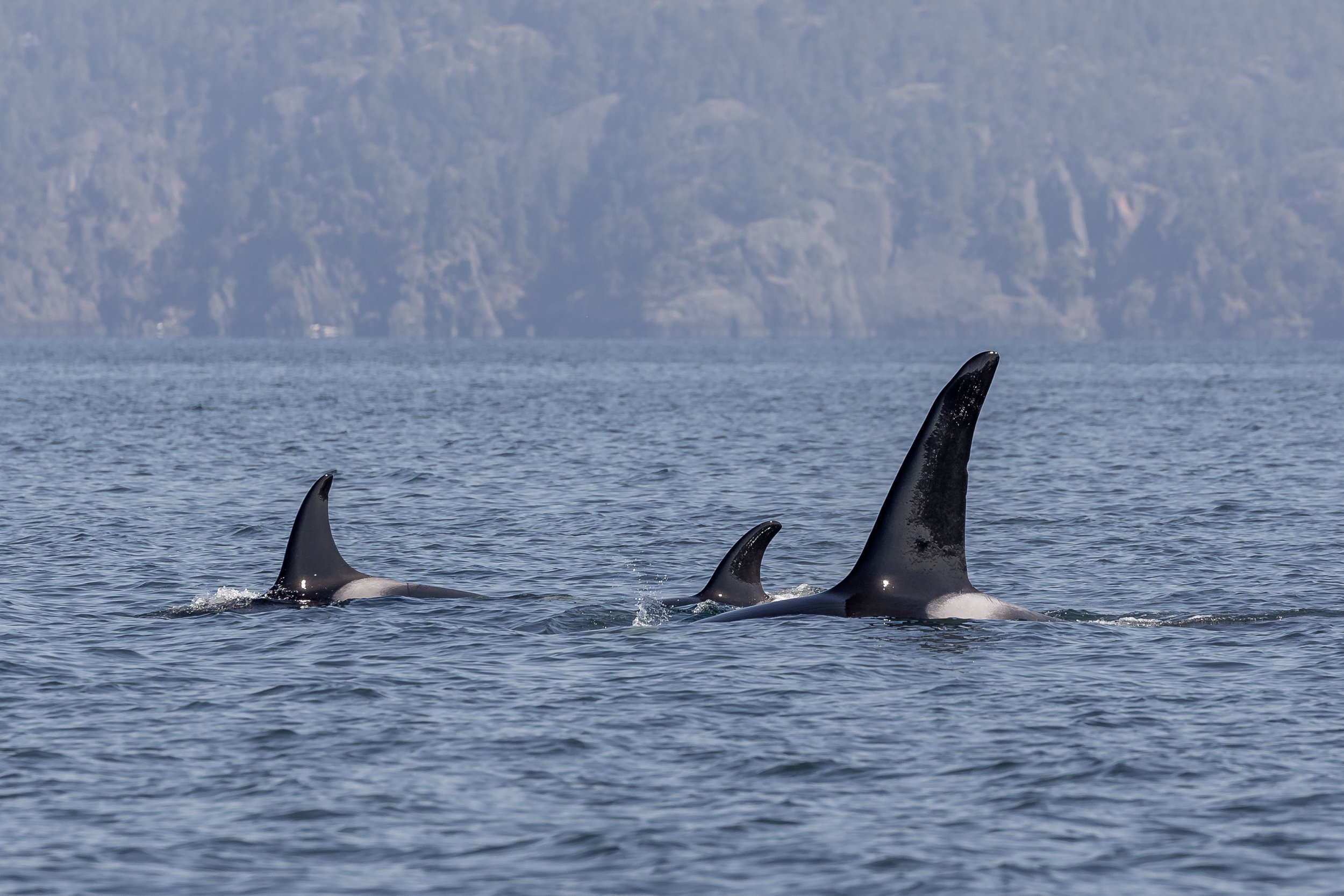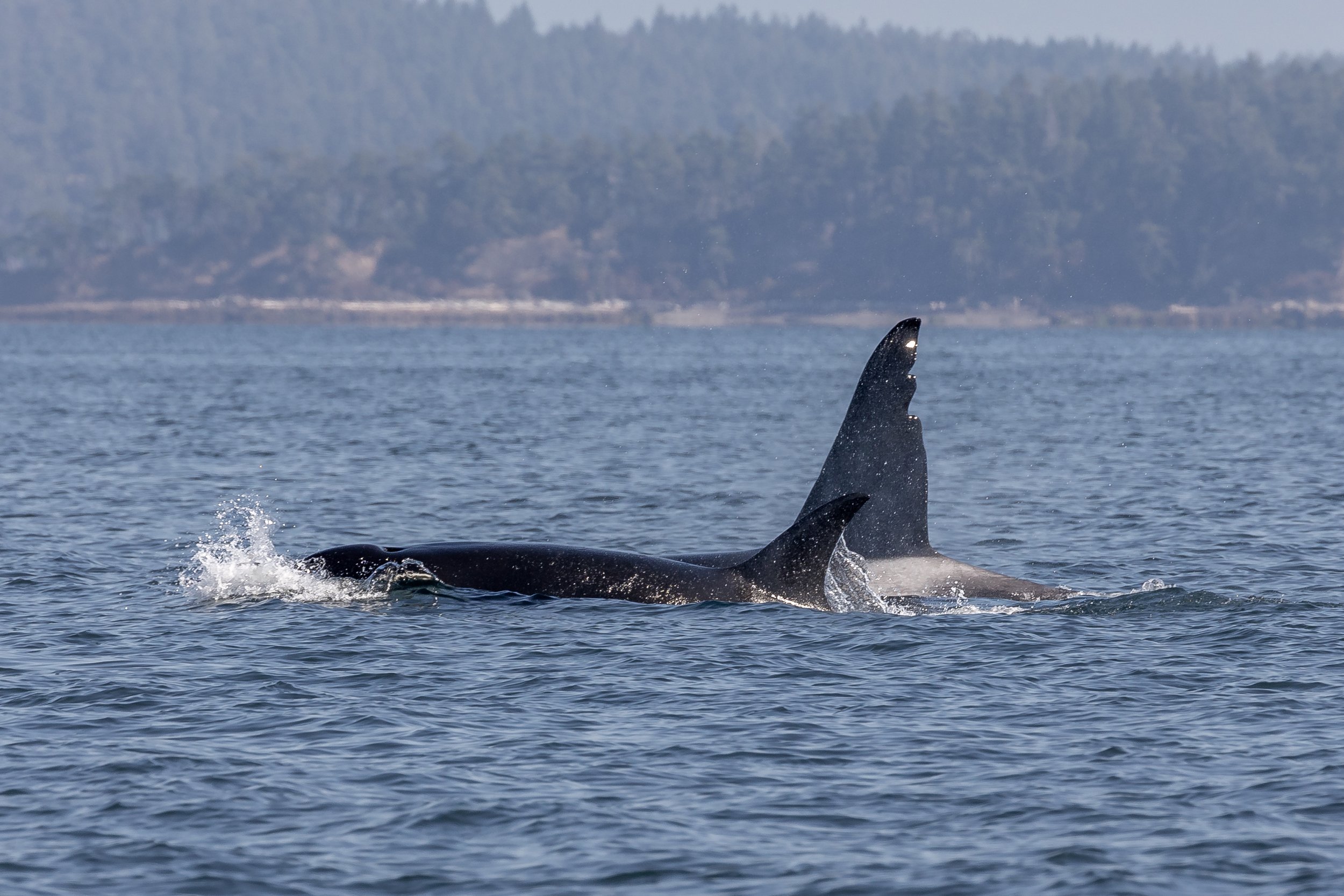September 15, 2023, 10:30 AM - Another exciting Double-species Day!
It was a gorgeous day when we began our journey northward in search of whales. Our Semi-covered vessel and Open vessel split up to cover as much ground as possible. It wasn’t long until our vessels spotted blows - a telltale sign that there were whales nearby. Our semi-covered vessel had spotted orca! When we approached we realized with a large T-party (group of multiple pods) of orca! This T-party was ID’d as 4 different pods, consisting of 11 whales:
T046B1 Tread ♀ (2003)
T046B1A Tsakani ♀ (2015)
T046B1C (2022)
T065 Whidbey II ♀ (~1971)
T063 Chainsaw ♂ (~1978)
T100 Hutchins ♀ (~1979)
T100C Laurel ♂ (2002)
T100F Estrella (2014)
T101 Reef ♀ (≤1969)
T101A Rush ♂ (1993)
T101B Lagoon ♂ (1997)
Our Open vessel would join in the party fun a bit later, as they were able to locate 3 other humpbacks close by while they were making their way to the orca. These 3 humpbacks were ID’d as Graze (BCY0523), her 2023 calf, and Lucky (BCZ0419).
Usually, when we nickname our humpbacks, we nickname them based on the characteristics of their flukes. Some whales such as Two Spot have pretty self-explanatory names. Other whales, such as Lucky, might not be as easy to understand if you are unfamiliar with humpbacks. You’ll notice below that Lucky has a number of dark, straight lines through their fluke. These lines were not present at birth - these marks, also known as rake marks, are likely from an orca attack. Due to the number of rake marks and the severity of the damage on their fluke, it is likely that Lucky was attacked by a pod or group of orca. Hence how Lucky got their name - they are “lucky” that they survived the ordeal!
After stopping with Graze, her calf, and Lucky for a little while, our Open vessel continued on its way and met up with Kula our Semi-covered vessel to watch the T-party.
This particular T-party was extra impressive as there were 4 large males present - these big boys with their 6-foot-tall dorsal fins are always the stars of the encounter as they crash through the surf and travel beside their (relatively) tiny mothers and siblings. Even though there were multiple pods travelling together, the whales for the most part were still seen travelling closest to their own pod members. T063 Chainsaw was always right beside his presumed mother T065 Whidbey II, T100C Laurel was often nestled between his mother T100 Hutchins and sibling T100F Estrella, and T101A Rush and T101B Lagoon were always side-by-side. T046B1 Tread was spotted with her young calf T046B1C in front of her for most of the encounter, with T046B1A Tsakani by her side. T101 Reef was really the odd one out today, as she seemed to just be swimmingly along by herself.
This party travelled north past Lantzville and started mingling around the Ballenas Islands. They were likely hunting as we spotted the pod members popping up amongst the small rocky crags - common hangout spots for Harbour seals, one of their favourite prey animals.
After leaving our T-party behind we turned our boats southward - our goal was to hopefully relocate the humpbacks our Open vessel had spotted earlier. Well, we sort of managed that! We were able to once again find Lucky (BCZ0419), but they had now buddied up with Uluka (BCX1702) and Pepper (BCX1706). This trio was diving and fluking, likely busy feeding on krill or schooling fish below the surface of the ocean. Once we departed these 3 we started making our way back towards home port. Well, our Open vessel’s whale luck was still going strong, as they located another 3 humpbacks after they left these three!
They ID’d this new trio as Two Spot (BCZ0432), Velvet (BCY1186), and 1 Unknown who did not fluke. If we are able to get an ID on their friend from their dorsal, we will update this blog!
These three were being extra naughty. While we were watching them, the trio suddenly started approaching a nearby sailboat. This isn’t uncommon as our humpbacks are naturally quite curious. Today, however, was a bit different. Normally our humpbacks will take a little look at boats and then continue on their way - Velvet, Two Spot, and their friend decided this sailboat looked like a fun toy and began surfacing and diving very close to the boat and its accompanying dingy, much to the excitement of the people on board. These three kept following and diving with the vessel for a while before they continued on their way. It was quite a sight to see!
Once that excitement was over, our vessels continued back towards Nanaimo. There was a quick pitstop at Harmac to see our sea lions who were being very rambunctious. Our California sea lions were spotted jousting - a behaviour characterized by two sea lions lunging forward, often crossing necks, and nipping and barking at each other. There are a couple of reasons why our sea lions may be jousting. They could be playing, preparing themselves when the real jousting will start in the breeding grounds, or they may be asserting dominance over each other to see who gets the best spots to sit and sleep.
Photos by Marine Naturalists Cheyenne Brewster or Vanessa Vereschahen.
The T100s travelling: T100C Laurel, T100 Hutchins, and T100F Estrella. Photo by Vanessa Vereschahen.
Big boy T063 Chainsaw and his mother T065 Whidbey II. Photo by Vanessa Vereschahen.
T101 Reef with her face out of the water. Photo by Vanessa Vereschahen.
T100 Hutchins beside her son T100C Laurel. Photo by Cheyenne Brewster.
T100 Hutchins, T100F Estrella, and T100E Laurel travelling together. Photo by Cheyenne Brewster.
T065 Whidbey II and her son T063 Chainsaw. Photo by Cheyenne Brewster.
Brothers T101A Rush and T101B Lagoon. Photo by Cheyenne Brewster.
The T046B1s charging forward, with little baby T046B1C in the lead. Photo by Cheyenne Brewster.
T046B1C is significantly lighter in colour than her mother T046B1 Tread (behind) right now. Photo by Cheyenne Brewster.
Graze (BCY0523)’s distinct dorsal. Photo by Vanessa Vereschahen.
Lucky (BCZ0419) travelling with Graze (BCY0523) and Graze’s 2023 calf. Photo by Vanessa Vereschahen.
Uluka (BCX1702)’s dorsal. Photo by Vanessa Vereschahen.
Uluka (BCX1702)’s fluke. Photo by Vanessa Vereschahen.
Lucky (BCZ0419)’s wiggly and heavily damaged fluke. Photo by Vanessa Vereschahen.
A clearer shot of Lucky (BCZ0419)’s rake mark-covered fluke. Photo by Cheyenne Brewster.
Two Spot (BCZ0432)’s gorgeous fluke. Photo by Vanessa Vereschahen.
Velvet (BCY1186)’s fluke. Photo by Vanessa Vereschahen.
Pepper (BCX1706)’s fluke. Photo by Cheyenne Brewster.
Going for a dive! Photo by Vanessa Vereschahen.
Two Spot (BCZ0432) going to check out a small sailing boat. Photo by Vanessa Vereschahen.
The size difference between Two Spot (BCZ0432)’s fluke and the sailboat’s dingy was absolutely crazy! Photo by Vanessa Vereschahen.
Photo by Vanessa Vereschahen.
Photo by Vanessa Vereschahen.
Our California Sea lions look extra sleepy right when they get back from their migration. Photo by Cheyenne Brewster.
Scritch scratch! Photo by Cheyenne Brewster.
The California sea lions were neck jousting. Photo by Cheyenne Brewster.
Someone is getting overpowered! Photo by Cheyenne Brewster.
California sea lions continue to fight. Photo by Cheyenne Brewster.




























